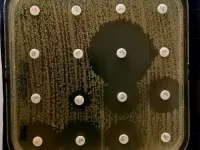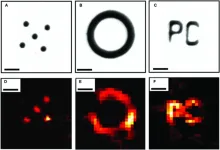(Press-News.org)
ALBUQUERQUE, N.M. — In a major breakthrough in the fields of nanophotonics and ultrafast optics, a Sandia National Laboratories research team has demonstrated the ability to dynamically steer light pulses from conventional, so-called incoherent light sources.
This ability to control light using a semiconductor device could allow low-power, relatively inexpensive sources like LEDs or flashlight bulbs to replace more powerful laser beams in new technologies such as holograms, remote sensing, self-driving cars and high-speed communication.
“What we’ve done is show that steering a beam of incoherent light can be done,” said Prasad Iyer, Sandia scientist and lead author of the research, which was reported in the current issue of the journal Nature Photonics. The work was funded by the Department of Energy’s Office of Science.
Incoherent light is emitted by many common sources, such as an old-fashioned incandescent light bulb or an LED bulb. This light is called incoherent since the photons are emitted with different wavelengths and in a random fashion. A beam of light from a laser, however, does not spread and diffuse because the photons have the same frequency and phase and is thus called coherent light.
In the team’s research, they manipulated incoherent light by using artificially structured materials called metasurfaces, made from tiny building blocks of semiconductors called meta-atoms that can be designed to reflect light very efficiently. Although metasurfaces had previously shown promise for creating devices that could steer light rays to arbitrary angles, they also presented a challenge because they had only been designed for coherent light sources. Ideally, one would want a semiconductor device that can emit light like an LED, steer the light emission to a set angle by applying a control voltage and shift the steering angle at the fastest speed possible.
The researchers started with a semiconductor metasurface that had embedded tiny light sources called quantum dots. By using a control optical pulse, they were able to change, or reconfigure, the way the surface reflected light and steer the light waves emitted from the quantum dots in different directions over a 70-degree range for less than a trillionth-of-a-second, marking a significant success. Similar to laser-based steering, the steered beam restrained the tendency of incoherent light to spread over a wider viewing angle and instead produced bright light at a distance.
Taming light
A feat previously considered impossible, the team’s proof-of-principal work paves the way for developments in the fields of nanophotonics and ultrafast optics. The ability to dynamically control incoherent light sources and manipulate their properties offers a wide range of applications.
One low-power use would be to brighten military helmet screens used to overlay maps or blueprints over ordinary vision. “In applications where space is valuable,” Iyer said, “steering light emission with low-size-and-weight metasurface-LED displays could be made possible in the future with this technology. We can use the light emitted in a better way rather than just turning them off and on.”
The technique could also provide a new kind of small display that can project holographic images onto eyeballs using low-power LEDs, a capability of particular interest for augmented and virtual reality devices. Other uses could be in self-driving cars where LIDAR is used to sense objects in the path of the car.
In terms of expressions of interest, the team has had several inquiries from commercial sources, said Sandia researcher Igal Brener, a paper author and lead scientist on the project. “A commercial product could be 5-10 years out, especially if we want to have all the functionality on-chip,” Brener said. “You wouldn’t use a control optical pulse to impart the changes in the metasurface needed to steer the light, but rather you would do this control electrically. We have ideas and plans, but it’s still early. Imagine an LED light bulb that can emit light to follow you. Then you wouldn’t waste all that illumination where there’s nobody. This is one of the many applications that we dreamed about with DOE years ago for energy efficiency for office lighting, for example.”
Similarly, tamed light may one day offer benefits in scenarios where focused illumination is only needed in a specific area of interest, such as surgery or in autonomous vehicles.
The future is looking bright for incoherent light.
END
Yevette Richards, Associate Professor, History and Art History, received funding to write a book about northern Louisiana.
The book will be a regional study of how kinship networks were central to the production of systemic racist terror and the subsequent erasure of its memory.
Richards will investigate a broad spectrum of racist violence from Reconstruction to the 1940s. She will show how white family networks functioned over time and across multiple parishes to serve as both incubators of racist violence and shields ...
Media contacts:
Robin Marks, 628-399-0370
Robin.Marks@ucsf.edu | @UCSF
Julie Langelier, 415-734-5000
julie.langelier@gladstone.org | @GladstoneInst
New Data Show Therapies May Activate Lymph Nodes to Produce Tumor-Tackling T Cells
Cancer treatment routinely involves taking out lymph nodes near the tumor in case they contain metastatic cancer cells. But new findings from a clinical trial by researchers at UC San Francisco and Gladstone Institutes shows that immunotherapy can activate tumor-fighting T cells in nearby lymph nodes.
The ...
Shigellosis, a highly contagious diarrheal disease, is caused by Shigella bacteria circulating in industrializing countries but also in industrialized countries. Scientists from the French National Reference Center for Escherichia coli, Shigella and Salmonella at the Institut Pasteur who have been monitoring Shigella in France for several years have detected the emergence of extensively drug-resistant (XDR) strains of Shigella sonnei. Bacterial genome sequencing and case characteristics (with most cases being reported in male adults) suggest that these strains, which originated in South Asia, mainly spread among men who have sex with men (MSM). This observation needs to ...
Motivated by the limitations of scanning approaches to photoacoustic microscopy, an international group supervised by Emmanuel Bossy of Université Grenoble Alpes experimented with structured illumination using known and unknown speckle patterns. One of their experiments produced the first demonstration of the use of blind structured illumination for photoacoustic imaging through a diffuser.
The group’s research was published Jan. 11 in Intelligent Computing, a Science Partner Journal.
The research article concludes that “photoacoustic microscopy can harness many of the structured illumination methods developed initially for pure optical ...
More than five million people in the United States live with some form of paralysis and may encounter difficulties completing everyday tasks, like grabbing a glass of water or putting on clothes. New research from Carnegie Mellon University's Robotics Institute (RI) aims to increase autonomy for individuals with such motor impairments by introducing a head-worn device that will help them control a mobile manipulator.
Teleoperated mobile manipulators can aid individuals in completing daily activities, but many existing technologies like hand-operated joysticks or web interfaces require a user to have substantial fine motor skills to effectively ...
People whose mothers are overweight during pregnancy and nursing may become obese as adults because early overnutrition rewires developing brains to crave unhealthy food, according to a Rutgers study in Molecular Metabolism.
Rutgers researchers traced this link from mother to child in mice with an experiment that began by letting some mice get obese on unlimited high-fat food during pregnancy and breastfeeding while keeping others slim on limitless healthy food. They found that mice born to obese mothers stay slim in adulthood on unlimited healthy food but overeat more than mice born to lean mothers when given access to unhealthy food.
The ...
Efforts to understand the effects of immigration enforcement on crime have largely been informed by police crime statistics. In a new study, researchers used longitudinal data from the U.S. National Crime Victimization Survey (NCVS) to assess the impact of federal immigration policies on local communities. They found that activation of two policies—the Secure Communities Program and 287(g) task force agreements—significantly increased the risk of violent victimization among Latinos.
The study, by researchers at Penn State University and the University of Maryland (UMD) at College Park, ...
BOSTON, MA -- Research published today in the JAMA Internal Medicine finds that developing postoperative delirium is associated with a 40% faster rate of cognitive decline over those who do not develop delirium.
“Delirium is associated with faster cognitive decline,” said Zachary J. Kunicki, PhD, MS, MPH Assistant Professor located at the Warren Alpert Medical School of Brown University, the first author. “Whether delirium causes this faster rate of decline, or is simply a marker of those who are at risk of experiencing faster ...
About The Study: The findings of this study suggest a consistent, widespread, and significant decline in activity following the onset of COVID-19 in the United States. Vulnerable populations, including individuals at a lower socioeconomic status and those reporting worse mental health in the early COVID-19 period, were at the highest risk of reduced activity. The researchers found a significant decline in daily step counts that persisted even after most COVID-19–related restrictions were relaxed, suggesting COVID-19 affected long-term behavioral choices. It is currently unknown whether this reduction is steps is clinically meaningful over time.
Authors: Evan L. ...
About The Study: The results of this study of National Institutes of Health (NIH)-funded surgeons suggest that women surgeons remained underrepresented among surgeon-scientists over a 25-year period despite early career success in receiving NIH funding. These findings suggest that substantial additional support for women surgeon-scientists is necessary to achieve a gender-diverse surgical research workforce.
Authors: Mytien Nguyen, M.S., of the Yale School of Medicine in New Haven, Connecticut, is the corresponding author.
To access the embargoed study: Visit our For The Media website at this link https://media.jamanetwork.com/
(doi:10.1001/jamanetworkopen.2023.3630)
Editor’s ...




